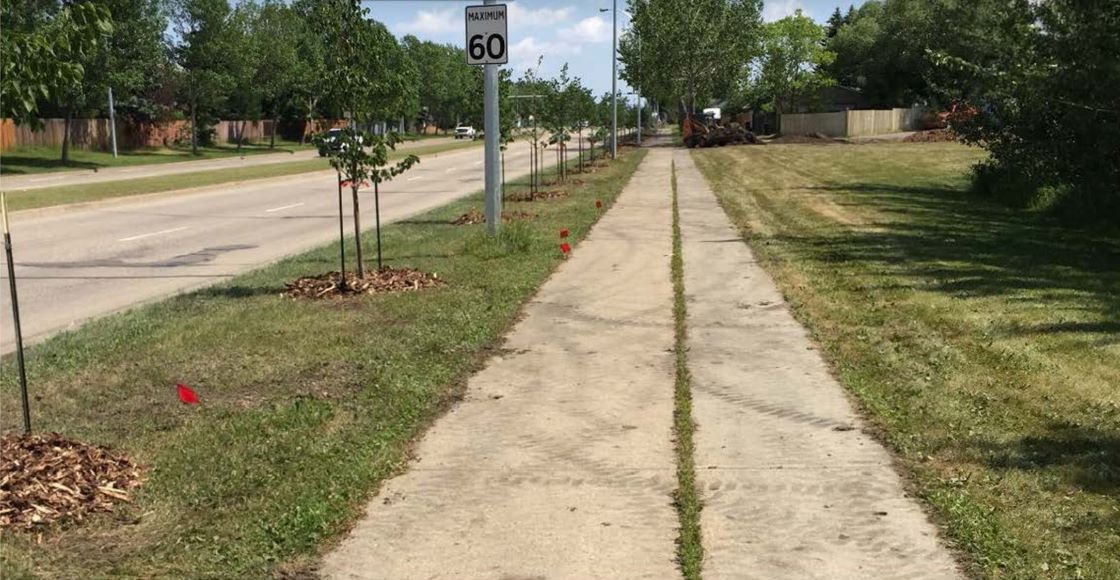Many YEG trees planted in circumstances constrained by concrete and other infrastructure
The Wildflower News July edition features information that Jim Hole, a well-known horticulturalist, submitted to the City’s Integrated Pest Management Advisory Committee, of which he is a member. Hole writes, “Construction impacts are cumulative. Trees do not heal, they just compartmentalize damage, wall it off. Each event adds up over time: demolition, grading, and construction. Cumulative damage sends trees into a death spiral.
Tree preservation requires space. Compacting soil around trees with construction equipment causes serious damage. Tree roots do not grow like carrots. They spread wide and most are in the top two feet of soil. Most fine roots are in the top 18 inches. Compaction reduces water infiltration and dramatically reduces oxygen infiltration.
Tree root zone volumes and soil consistency are critical. Two cubic feet of structured soil for every square foot of crown projection at maturity is needed for healthy trees. Crown projection is the area under the dripline of a tree. If you think of a circle of foliage and do the math, a canopy diameter of 20 feet would be around 300 square feet and require 600 cubic feet of good soil.
The typical urban tree pits in concrete sidewalks might have a volume of 100 cubic feet. Tree roots are unable to grow properly in these ‘tree coffins’ and are, invariably, short-lived. Each successive replacement tree will also be short-lived. Costs in the long term are higher and environmental and aesthetics losses are also high.” https://speakerscanada.com/keynote-speaker/jim-hole/
Edmonton valley zoo breeding program includes endangered northern leopard frog
Northern leopard frog populations across western Canada started declining sharply in the 1970s, with the Edmonton region population estimated to have been completely lost by the 1980s. Due to upland habitat destruction, wetland loss, pollution, and the spread of diseases, the species is now considered gone from the entirety of the North Saskatchewan River basin.
In late June 2023, two zookeepers made the trek to a protected wetlands area outside of Kimberley, B.C. to release 277 zoo-born and raised endangered Rocky Mountain northern leopard frog tadpoles. This work is part of a breeding program with the goal of preventing the local extinction of the species in order to support the recovery of the broader western Canadian northern leopard frogs, which are considered at risk in Alberta.
The northern leopard frog program was established at the zoo in 2018 as part of the broader Northern Leopard Frog Recovery Team, which runs in cooperation with the Wilder Institute/Calgary Zoo, the Vancouver Aquarium, and the Province of British Columbia. The team is establishing new self-sustaining populations of frogs in BC, conducting conservation research, and maintaining assurance populations.
For every person who visits the Edmonton Valley Zoo, a small portion of their admission goes to conservation.
New conservation easement in Parkland County near Wabamun Lake
The Edmonton and Area Land Trust (EALT) has announced that a new conservation easement was finalized earlier this year with landowners in Parkland County. This property near Wabamun Lake provides mixed woods habitat for many types of wildlife: moose, deer, bear, dozens of songbirds, and even the endangered Little Brown bat.
In addition to the generous landowners who made this possible, funding support was also received from the Alberta Land Trust Grant. Land Trusts can apply for funding from this provincial program to conserve ecologically important areas to prevent habitat fragmentation, maintain biodiversity and preserve native landscapes.
Conservation easements are an excellent tool for landowners to achieve conservation of their land while still being able to use and sell their land in the future. Ecologically significant lands may also be eligible for significant tax benefits through the Ecological Gifts program, a program of the Government of Canada.
If you are interested in conserving your land with EALT, check out its Planning Your Conversation Legacy guide https://www.ealt.ca/conserve-nature/
YEG will keep control if river valley becomes a national urban park
Miriam emailed “Always interesting news! Would love a follow up on the Edmonton park control issue.”
Still Life by Andrew French, Belgravia Art Park
https://www.edmontonarts.ca/public-art/still-life-2
Comment or contribution
Please note that articles may not reflect the position of NSRVCS. River Valley News is meant to be a clearinghouse for the wide variety of opinions and ideas about Edmonton’s River Valley. Email river valley photos, event information, comments, or questions to nsrivervalley@gmail.com
Sincerely yours,
Harvey Voogd
North Saskatchewan River Valley Conservation Society
780.691.1712





